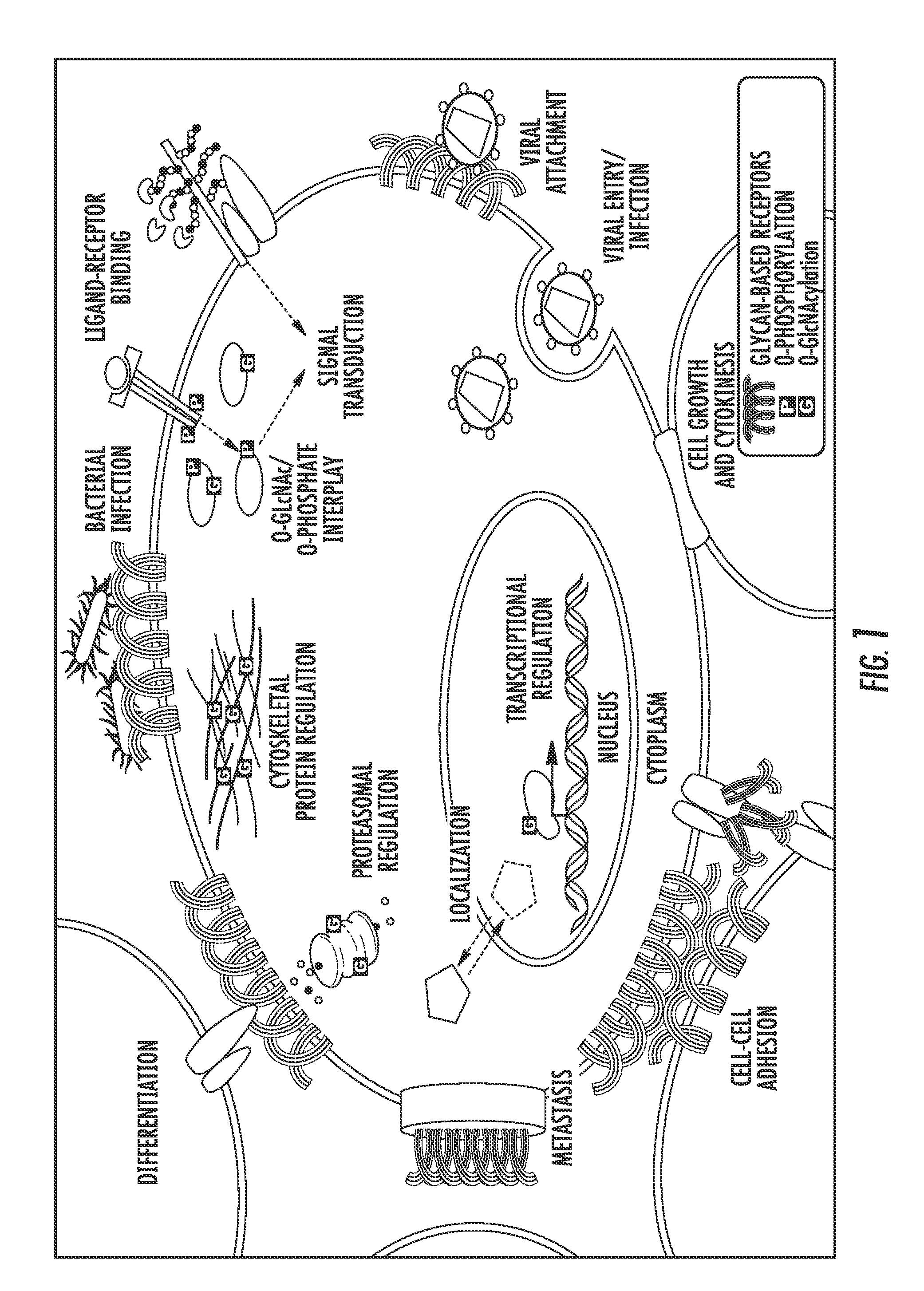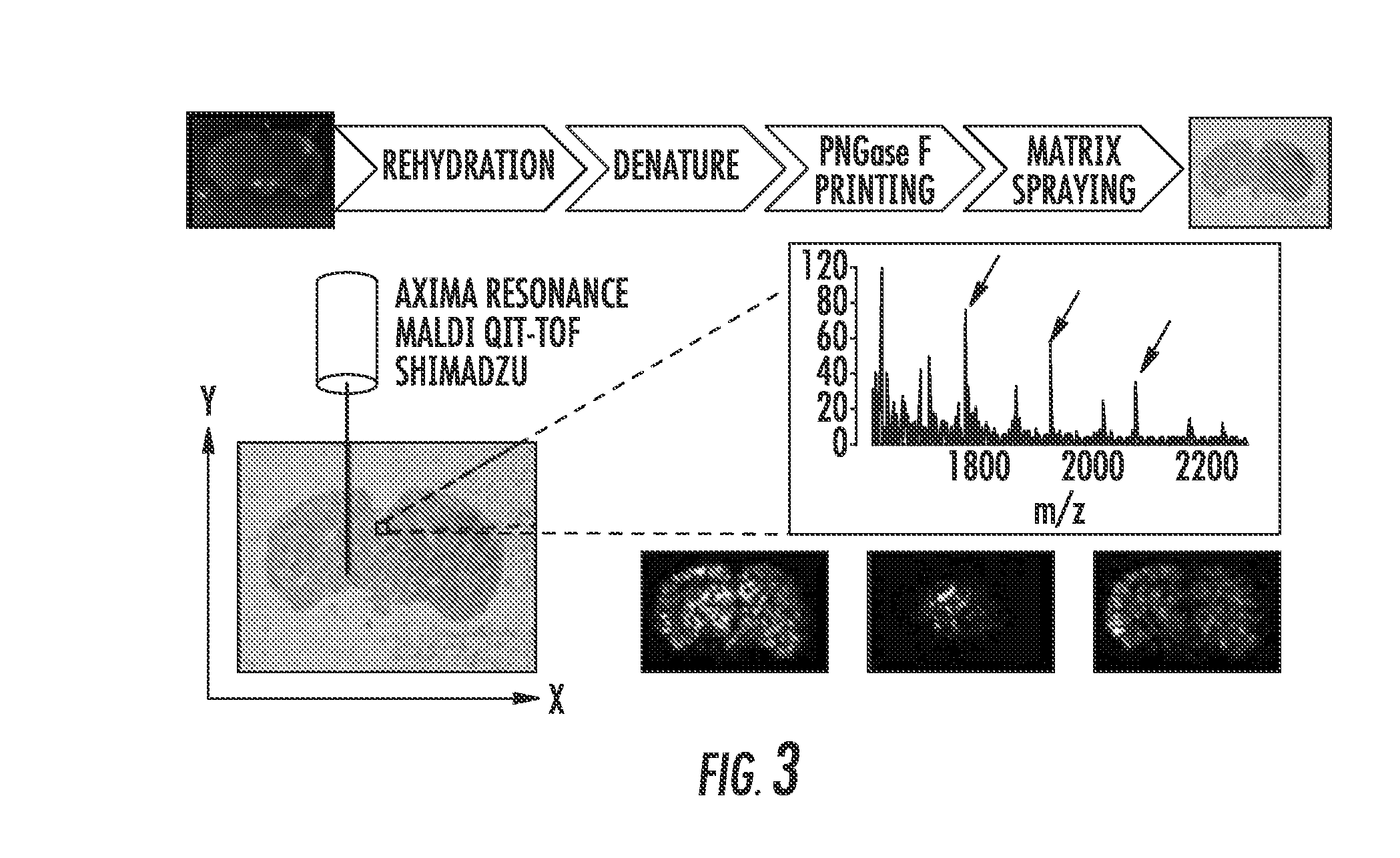Mass spectrometry imaging of glycans from tissue sections and improved analyte detection methods
a mass spectrometry and tissue section technology, applied in the field of mass spectrometry imaging of glycans from tissue sections and improving analyte detection methods, can solve the problems of compromising the sensitivity and detectability of low-abundance analytes, few monoclonal antibodies have been developed for glycans, and ineffective analysis of low-abundance molecules from complex mixtures. achieve the effect of improving the limit of detection of one or mor
- Summary
- Abstract
- Description
- Claims
- Application Information
AI Technical Summary
Benefits of technology
Problems solved by technology
Method used
Image
Examples
example 1
[0079]Mass spectrometry imaging of glycans from tissue section. FIG. 3 shows a representative schematic of an imaging platform using the inventive methods. A FFPE tissue section is rehydrated, the proteins in the tissue section are denatured, and microarray printing using the release agent PNGase F is allowed to occur. PNGase F is the enzyme that cleaves N-linked glycans from their host proteins. To preserve the spatial distribution of the glycans, a microarray printer can be used to apply the PNGase F on the tissue in a grid. Then, a matrix, such as 2,5-dihydroxybenzoic acid (DHB), can be sprayed over the tissue using an airbrush. The tissue can then be analyzed with a mass spectrometer (Axima Resonance MALDI QIT-TOF, Shimadzu). One difference between a conventional MALDI analysis and the methods of the present invention is that the tissue is raster scanned by the laser in the x and y directions and mass spectra are acquired for each pixel on the tissue. At this point, by mapping t...
example 2
[0087]Concentration Dependent Sensitivity and SD. Sensitivity and standard deviation (SD) of an analyte greatly depend on the concentration of the target analyte in the sample. To illustrate the dependence, we calculated the sensitivity and SD versus analyte concentration using Angiotensin II as an example and the results are shown in (FIG. 13). The calibration curve of Angiotensin II was generated by analyzing sequential dilutions of this peptide with the mass spectrometer. The sensitivity was calculated from the calibration curve by dividing the signal difference by the concentration difference for two adjacent data points at each concentration. The standard deviation was computed from ten normalized mass spectral signals and is denoted as SD. Due to the sigmoidal shape of the calibration curve (FIG. 11 and FIG. 13A), the sensitivity, i.e. the slope of this curve stays stable at its maximum value over the linear range of the assay, and decreases as the concentration falls below th...
example 3
[0088]Determining LODs of Target Analytes in Simple Mixture. To determine whether the LOD could be lower with the target analytes spiked in TAD solution, we analyzed the target peptides in different dilutions in control solution (which did not have any spiking target peptides added) and in various TAD solutions (which had a different amount of target peptides spiked in the solution). The mass spectral peaks of Angiotensin I is depicted in FIG. 14 for the control and the TAD solution group. For this peptide, the measured LODorig was 64.5 fmol / μL. Therefore, the mass spectral peak of Angiotensin I (ma=1296.685), averaged over the ten measurements, is not distinguishable from the background at concentration of 31.25 fmol / μL (FIG. 14A). By spiking the target analyte with a concentration C=50 fmol / μL, the spectral signal is boosted and the LOD reduces to 22.5 fmol / μL. Consequently, as shown in FIG. 14B, the averaged mass spectral peak of Angiotensin I at the endogenous concentration of 3...
PUM
| Property | Measurement | Unit |
|---|---|---|
| concentrations | aaaaa | aaaaa |
| concentrations | aaaaa | aaaaa |
| mass | aaaaa | aaaaa |
Abstract
Description
Claims
Application Information
 Login to View More
Login to View More - R&D
- Intellectual Property
- Life Sciences
- Materials
- Tech Scout
- Unparalleled Data Quality
- Higher Quality Content
- 60% Fewer Hallucinations
Browse by: Latest US Patents, China's latest patents, Technical Efficacy Thesaurus, Application Domain, Technology Topic, Popular Technical Reports.
© 2025 PatSnap. All rights reserved.Legal|Privacy policy|Modern Slavery Act Transparency Statement|Sitemap|About US| Contact US: help@patsnap.com



